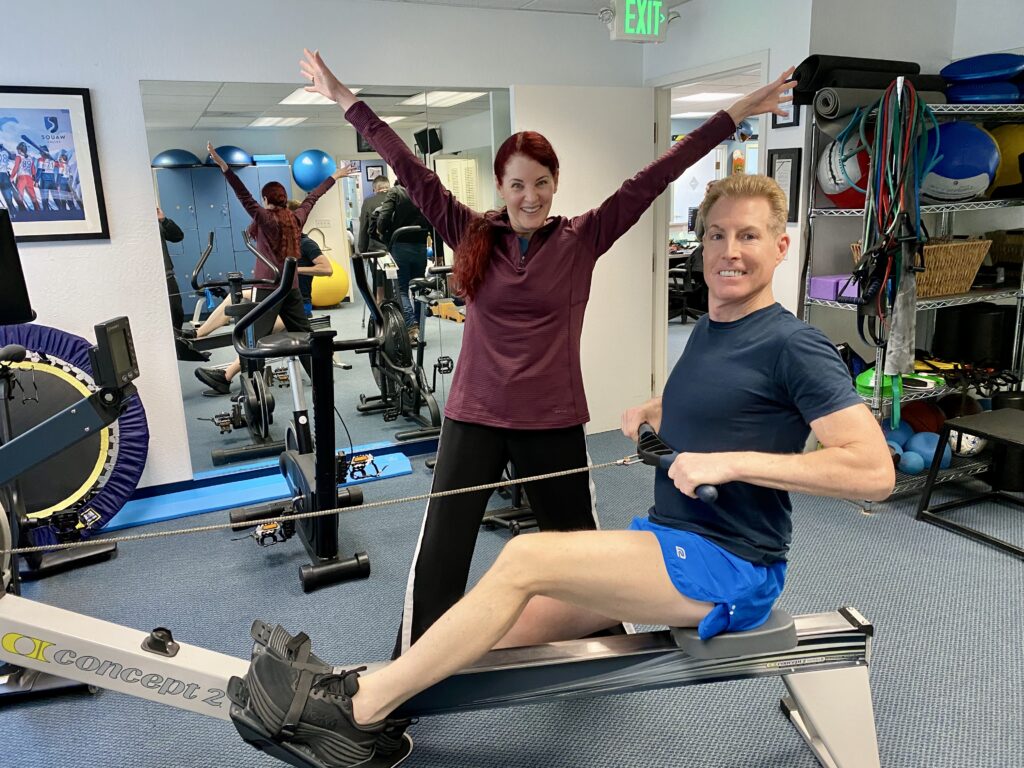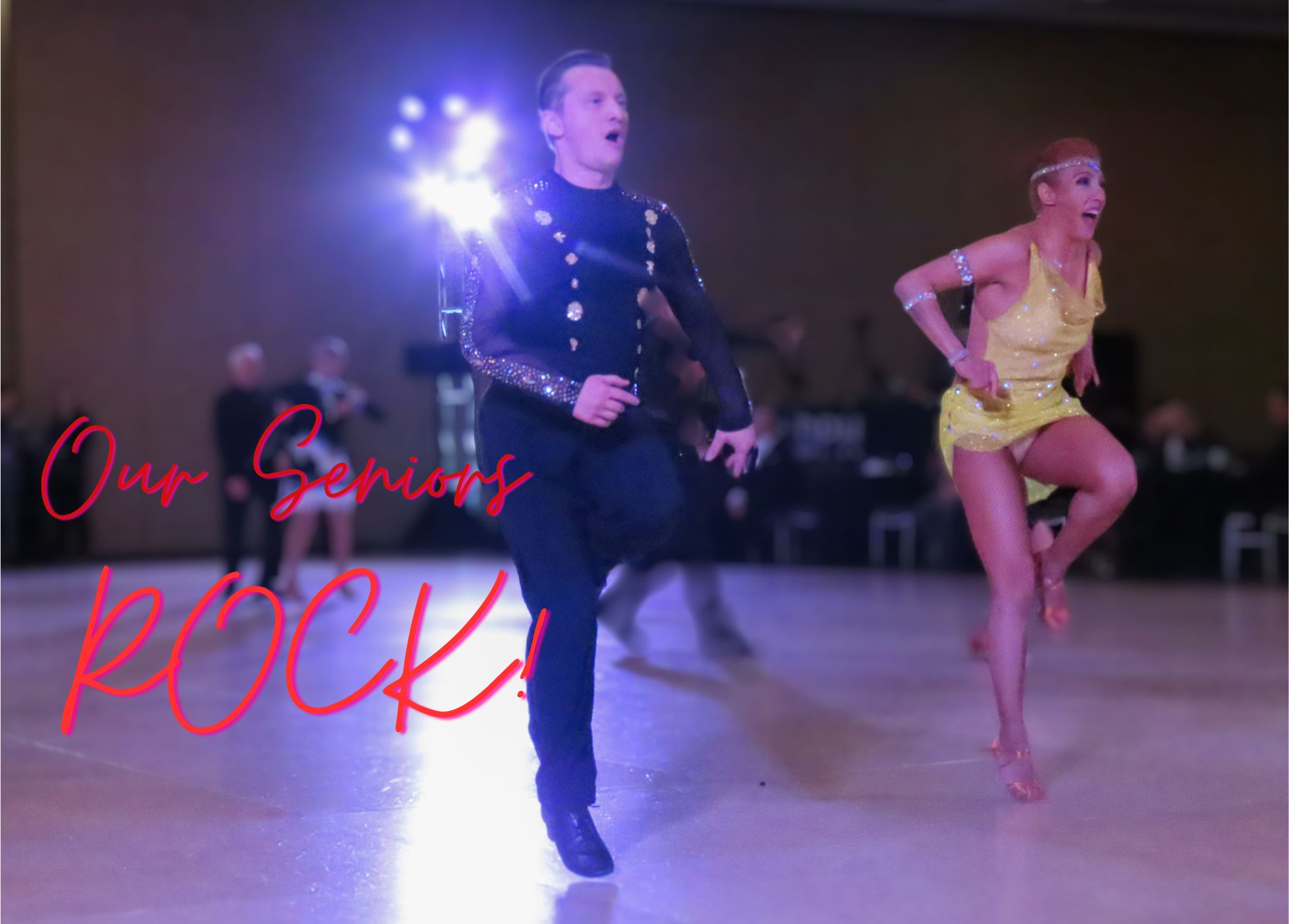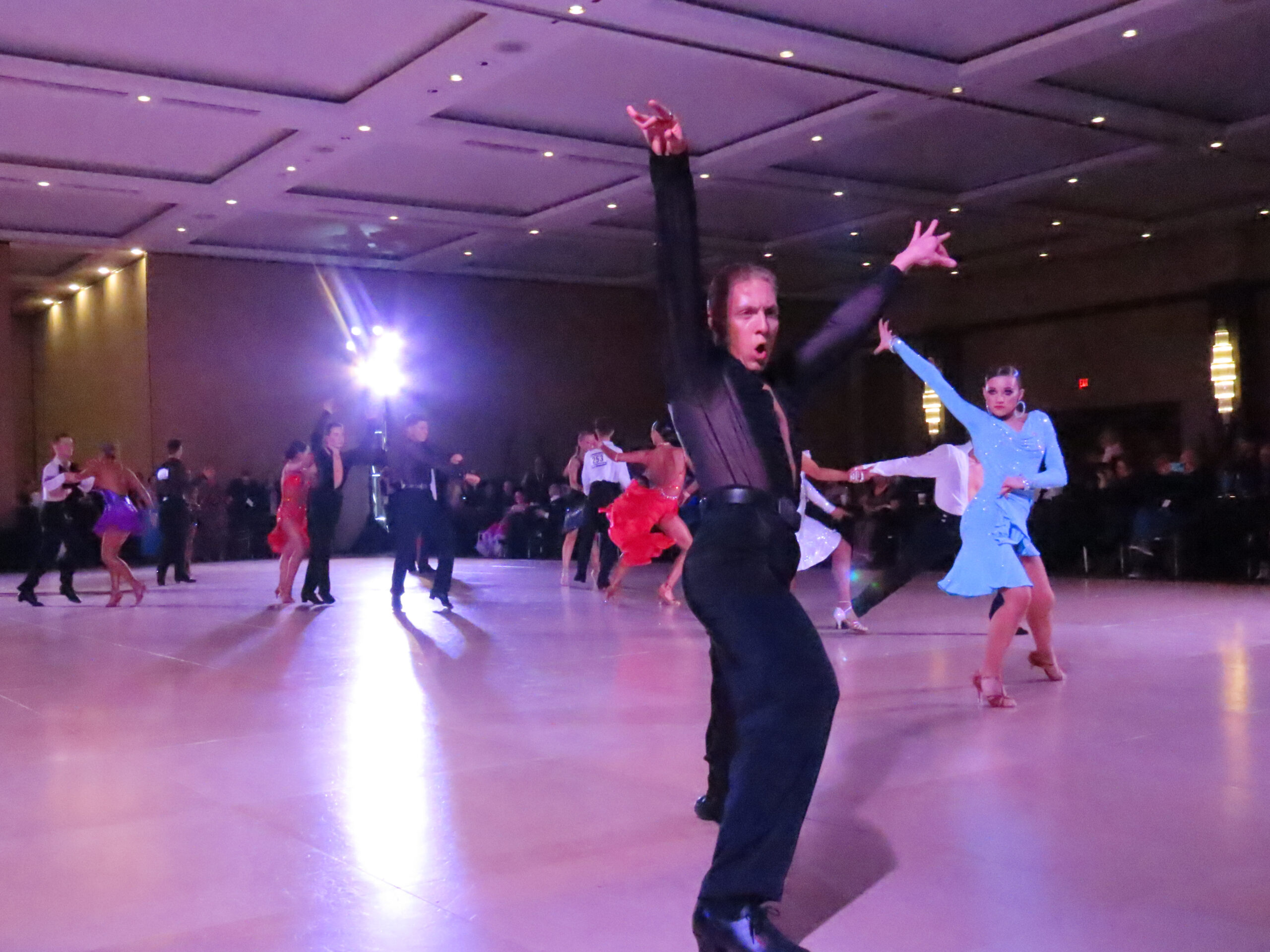You love dancing, but the pain is taking away your edge…and your fun. You’ve been to the doctor who says it is not going to get better. You could stop dancing or just slow down. No way! It is time to seriously consider joint replacement. Where do you start?
My Background
I am a 62-year-old retired Marine Corps Officer and DanceSport Athlete.
In the Summer of 2021, my right knee started to cause me pain due to years of wear and tear. I had semi-annual Hyaluronic Acid injections in September 2021, March 2022, and September 2022. At first, the relief worked for a few months, but by Fall 2022, the results were infective. Time to consider another approach. In December 2022, I completed X-Rays and an MRI of my Right Knee. Based on the medical imagery and in consultation with a local orthopedic surgeon, I received a recommendation for a Total Knee Replacement.
We did a lot of research and decided to consult with Dr. Kevin Stone, an Orthopedic Surgeon with The Stone Clinic in San Francisco, California. Dr. Stone specializes in the care of high-performance athletes.
Based on the same medical imagery, Dr. Stone recommended a Partial Knee Replacement for my Right Knee. I agreed that this was the best course and we proceeded. After creating a CT scan-based computerized 3-D model of the knee, Dr. Stone performs a partial knee replacement using the MAKO Robotic Arm-Assisted Orthopedic System, i.e., removing less bone and tissue, and accelerating the recovery time.
Dr. Stone conducted my Right Knee Lateral Unicompartmental Knee Replacement on March 28 in San Francisco.
Upfront
My advice in this article is not the end-all and be-all. However, as someone who recently went through Joint Replacement, I thought I would share what I have learned and hope it will be helpful. Please note that “we” are all different. What worked for me, might not work for you. My wife, Rose-Ann, and I had a definite thought process going into this. We also came up with a couple of lists of items (provided at the end of the article) to consider.
Research/Preparation/Evaluation/Pre-Op
Check your insurance plan. If you want the best, does your policy allow for out-of-network, non-local, specialty providers? Verify your insurance open enrollment season if a change is needed.
Be prepared to finance procedure costs. Insurance coverage may not apply to all or part.
Talk over matters with your family and your financial advisor.
Get as healthy as you can before surgery. A healthy body in motion heals faster. Do you need to lose weight? Do you need to tone up? This is also the reason not to wait until you are disabled; a disabled body will have a harder time repairing. A joint in need of repair will not get better on its own.
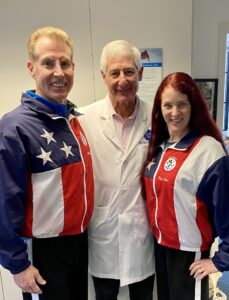
Do your research! Research the best surgeon in your state, region, country, and out of country. Read and watch articles, journals, magazines, books, reviews, and testimonials. Talk to friends, family, fellow dancers, athletes, etc. *We talked to dance friends, family members, and others who had replacement surgery – remember that a knee replacement is not the same as a hip replacement. Rose-Ann hit the internet and found the Stone Clinic and we both started reading the many testimonials by Dr. Stone’s patients — elite athletes of many ages and in many different sports (Olympic athletes, skiers, marathon runners, extreme sports, ballet dancers, tennis players, surfers, skaters, gymnasts, triathletes, soccer players, bikers, entire teams…the list goes on.) I read Dr. Stone’s book, “Play Forever,” and then pursued his free virtual consultation.
Use your primary care manager or physician for your X-rays and MRIs. Ask for any old films and reports. Ensure you have a disc of all. We found that it never hurts to take a few photos of the results when the doctor is displaying them. They will come in handy.
Schedule your consultations to review the medical imagery. Tell the doctors you will ask for a second opinion. Take notes and compare the recommendations. Again, this is your health. What is it worth to you?
Ensure you have at least two opinions on your medical procedure. Do not restrict yourself to local providers. Most people give more thought to buying or repairing their car than they do repairing their own knee. This is the health of your body. Again, what’s it worth to you? Consider your suggested alternatives and who has the best results. Consider what you want to be able to do when recovered.
Remember this is not just about the surgery and cost. Let the doctors know that you are different – you are a competitive ballroom dancer who wants to continue dancing. Your goal is not to go for a stroll in the park or to walk down the stairs; you want to dance the Quickstep/Jive at the competitive level. This is about expected results, time to heal, wear and tear on the body, and goals. *I explained my goals to Dr. Stone and sent him videos of our dancing. The doctor watched the videos and made my goals his own goals – Be prepared to compete on a “forgotten knee” at the 2023 Sr III World WDSF Championships, on October 27, in Platja d’Aro, Spain.
Make an informed decision on the provider and the procedure. This can make the difference between outcome, pain, and time loss with family/competition/life. *I chose to go with a Partial Knee Replacement. Dr. Stone’s evaluation of the X-rays and MRI revealed that my lateral meniscus had deteriorated, resulting in a bone-on-bone situation. However, the rest of my knee was healthy. Dr. Stone felt it was best to preserve the healthy tissue, thus allowing for a better (less painful) rehabilitation time and process. He felt that I would be able to train and compete at the World Championships in the fall. The local surgeon did not request an MRI. From the X-ray, he suggested a full knee surgery and said that I would “likely still be able to dance” after the procedure.
Talk it over with your dance coach(es). Let them know your situation and concerns. What is the best time for you to take off? What are your goals and how much time will you need to recover, train back up, and be ready to compete again?


Schedule your procedure in accordance with your goals and timeline. *We chose to compete at the 2023 USA Dance Nationals and wait a week. Then I had my surgery, in hopes of returning to workouts in preparation for competing at the WDSF Senior III World Championships in the fall. In hindsight, I might have had the surgery sooner and skipped the 2023 Nationals.
Consider participating in any studies that are currently being done by the surgeon. There might be great benefits to you. *I agreed to take part in a research study conducted by the Stone Research Center.
If the procedure is local, travel and logistics will be minimal. You will likely need a companion to help you get home and for the first few days after surgery. Your doctor will best advise you on this prior to the procedure.
If your procedure is not local, travel and logistics must be well-planned. * Rose-Ann and I traveled from Virginia to San Francisco for the surgery and stayed there for just under two weeks. Many people suggested that this would be a huge problem for us; it wasn’t. We planned it well and then worked our plan. The surgery, quick recovery, and immediate mobility were well worth the two weeks of a little inconvenience.
If you are not local, you also must understand the pre-operative appointments and how proximate these may be (time and location) to your surgery. Many top providers are prepared to accommodate long-distance and international patients and have available ombudsmen and admin staff to handle these types of questions. *The Stone Clinic, accustomed to working with out-of-town patients, scheduled the pre-operative requirements the day prior to surgery. They gave me a list of requirements and told me where to go to accomplish all.
Lodging – Use your hotel membership rewards programs for lengthy stays. Might as well earn points.
Check what pharmacies near the surgery site and hotel work with your insurance. *The pharmacy situation was very different on the West Coast, as compared to here on the East Coast. What we thought would be convenient (the local Walgreens, like at home), wasn’t. Instead, we discovered that a nearby Safeway had a pharmacy connected with our provider.
Preregister and bring in all paperwork.
Understand the public modes of transportation vs car rental and parking. *In my case, it was easier to take a cab every day. It was cheaper and more convenient than renting a car, paying for hotel parking, and trying to park at the clinic and hospital sites. Local dance friends – David and Allison Getchell – also visited and offered us a ride to the airport on the last day. Thank you, David and Allison!!
OK…You’ve done the research. Trust and believe in your surgeon and let them know you believe in them. Plan to be the best patient the doctor has ever had.
Day of Surgery
Since COVID, some surgery centers and hospitals have changed their rules about patients and family members. Make sure you know what they are before you go to the surgery site.
Follow any morning-of requirements.
Take a shower…you may not be taking one for a couple of days.
A travel companion is extremely helpful and may be a requirement.
Approach your surgery with a winning attitude. Walk in with your head up; be a champion! You want to win this one. Everyone is rooting for you, and no one is competing against you. *Rose-Ann and I checked in to pre-op in our USA Dance jackets, just like we showed up for Nationals the week before.
Dress like an athlete and be an athlete. *I approached surgery and each day of physical therapy like a competition — showered, shaved, and dressed to work.
Don’t dwell on the procedure, pain, and inconvenience. Look to the future. *My answer to ‘How are you doing?’ was, “Great!”
If you are taking a taxi from the surgery center/hospital, make sure the company knows your situation ahead of time and ask for a larger cab. *The taxi company easily accommodated us on surgery day; they asked for a 10-minute heads-up for the larger vehicle.


Post Op
Keep a medical and activity log. Narcotics may be prescribed but are not required, and you don’t want to take more than you need. *I did not take narcotics; I took regular Tylenol. The partial replacement, recommended by Dr. Stone, was less invasive, required less cutting, and resulted in less pain. My mentality going in was “Pain is just a word. It is not a mindset.”
After surgery, put your best foot forward every day. Plan to be a success story. *I considered each day of recovery a training day – TDay+1, TDay+2, etc.
Know that it will take you longer to do everything and to get everywhere. Plan for it.
If you are taking a taxi, let them know your situation – post-operative patient on crutches. Tip accordingly. *The San Francisco taxi drivers were very used to people traveling to their city for surgical procedures. Many were acquainted with the Stone Clinic. All were extremely accommodating to me on crutches.
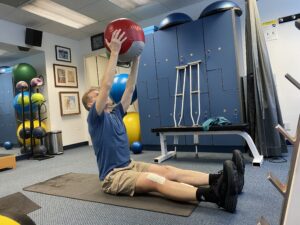

Approach your follow-on physical therapy with the same winning attitude. Again, you want to win this one. Everyone is rooting for you, and no one is competing against you.
Get out when you can. Baby steps. Decide not to eat in your room. Get out of bed and go out! Make it a goal to walk to the Starbucks a block away.
Rest – get sleep.
Eat well and drink lots of water. Push high proteins to help the healing process. Ask your doctor about a good post-op diet. Water and fluids are necessary in the healing process. Avoid processed sugars at this time; you can reward yourself later.
Rent suggested equipment. Now is not the time to skimp. *We rented the suggested Game Ready icing and compression equipment. It was well worth it.
Make sure you are medically cleared to fly. Get a note from your doctor to give to the airline. Wear your compression hose or whatever else pertains. *I was cleared to fly home in just less than two weeks. We took a direct flight and purchased front coach seats. I wore two compression hoses, took 81 mg aspirin, exercised in my seat, and got up hourly to avoid complications.
Research and line up your local Physical Therapist ahead of time – don’t just go with the most convenient. You are an athlete who aspires to more than just walk the aisle in the grocery store. You just did the surgery with the right surgeon. Do the follow-up with the right Physical Therapist. Commit to daily physical therapy and rehab as prescribed by your doctor. Do your at-home exercises. *Daily physical therapy started the day after my surgery. I did 1 ½ weeks of therapy at the Stone Clinic, flew home on a Friday, and started three days a week with my selected local Physical Therapist the following Monday.
Ask your surgeon about massages. Massages can be very beneficial in the healing process. A good Massage Therapist can take down swelling, reduce the pain, and help the healing process. However, they will want a doctor’s approval before starting to work on you after major surgery. *Dr. Stone told me that I could start massages as soon as I got home. I had one a week and it made a big difference to my knee, the healing process, and the rest of me.
Plan to do the work that goes with the procedure. It is not about speed; it is all about form. Follow the doctor’s orders. You don’t know it better than they do. Do your physical therapy, but don’t overdo anything. You trusted your doctor with your surgery; now, trust them with your recovery.
Post-surgery re-evaluation is not just an opportunity to say hello. Don’t skip these appointments.
With your doctor and therapist, develop a long-term plan for your return to the ballroom floor and stick with it, considering rest, recovery, and goals. Follow this plan. Yes, it is your body, but you will do maybe one or two surgeries of this magnitude in your life, the doctor does and sees many of these types of procedures a week. Don’t overdo, don’t underdo. Your body needs to heal.
You may hit a plateau around the third week of the healing process. It is normal. Plan to have friends over or to go somewhere that day. Give yourself something to look forward to. Enjoy telling your friends how well you are doing. *Dr. Stone warned us about this. We decided to go to the local social dance just to see friends and socialize. Rose-Ann also planned a fun dinner out with our good friends, Dan and Ann Sullivan.
Celebrate your milestones. Inspire others and yourself.
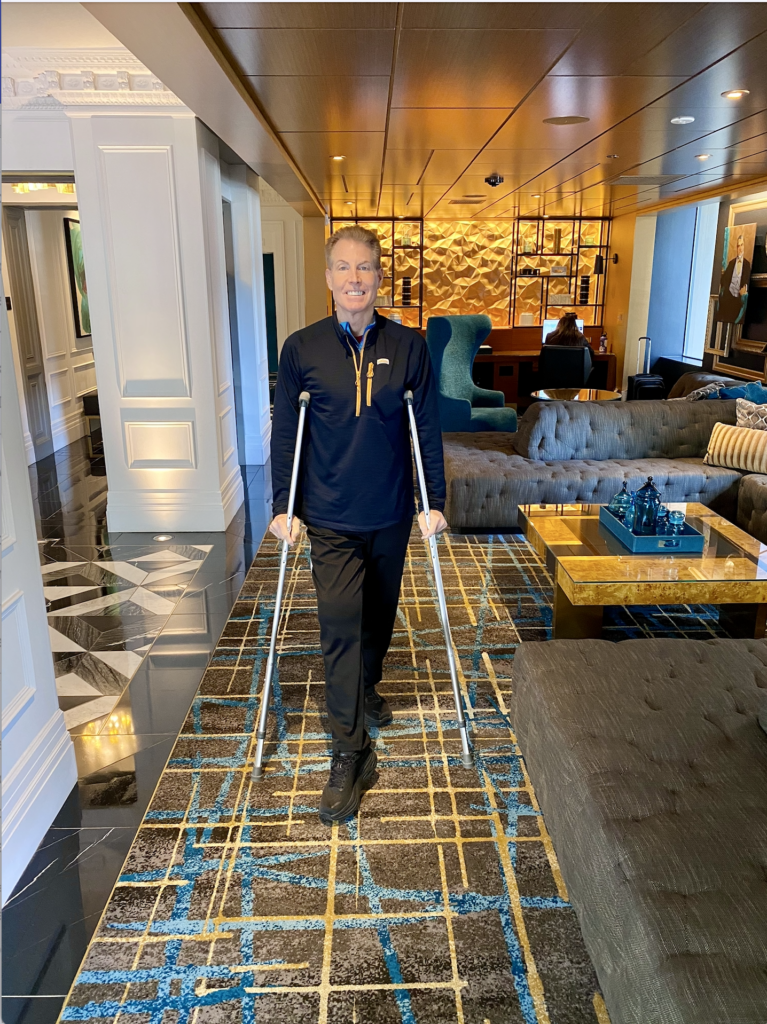

Conclusion
If a joint replacement or any other major surgery is in your future, I wholeheartedly recommend that you do your research. Find a surgeon that truly understands your goals as a high-performance athlete, whatever your age or activity. Rose-Ann and I are so very fortunate to have found Dr. Kevin Stone.
So how do I end this? First, let me thank my USA Dance family for your many well wishes as I continue through this process. How lucky we all are to have each other. Now for a little tough love: We have all heard the phrase, “Keep moving or die.” Well, I agree. If you are one of those who stopped moving or dancing, the alternative is not good. It is time to get started again. As Rose-Ann always says, “The dance floor is calling!”


List of items to consider for non-local surgery:
- Pet pads – save the sheets and furniture.
- Good scissors
- Clothes pins – hang items to dry, close curtains during the day, organize cords. — You would be surprised how handy these are.
- Painter or masking tape – Another item that is very handy to keep bandaging in place.
- Workout shoes – You will be working out. Have a real set of trainers.
- Loose warm socks
- Extra pajamas — thin wide legs
- Sweatshirt/jacket with a front zipper
- Shorts for PT and pre/post-op evaluations
- Sweats – dark with wide legs. They may become stained.
- Preprint sheets with all addresses and phone numbers — surgery site, hospital, hotel, office, pharmacy, X-rays, taxi companies. You want to hand it to the cab, Uber, etc.
- Flashlight, reading light — read medication, ice machine instructions, etc.
- Don’t overpack – you don’t want heavy luggage on the way home.
- A backpack might come in handy
- Time of year weather considerations
- Ankle socks
- Hats
- Rain gear/poncho — you can’t carry an umbrella with crutches!!!!
- Dress in layers
- Have a few face masks with you.
- Nightlight – this is not the time to be stumbling around in the dark in the hotel room
- List of all your medications and supplements
- Laundry soap
- Oh, Rose-Ann brought her dance shoes!
Hotel considerations for non-local surgery
- Member hotel points
- Discuss your situation with the hotel ahead of time, they might make some helpful suggestions.
- Two beds, possibly a suite — so you both can rest and not disturb each other
- Extra blankets – for heat while icing or for elevation purposes
- Ask to be on a floor with a working ice machine
- The gym will be important for additional or weekend physical therapy
- Restaurant in or attached to the hotel
- Distance from surgery and therapy sites. Remember that you will just go to the surgery site once. You will go to the doctor’s office and therapy sites multiple times. Walking distance has little advantage as you will not easily walk any distance for the first week.
- Handicap accessibility — like it or not, you will be temporarily handicapped.
- Covered overhang by the lobby — you will not be quick getting in and out of a car.
- Extra towels
- Remove unwanted furniture from your room.
- Working television
- Laundry facility for patrons
- Place to go when the patient is sleeping – lobby, coffee shop,
- Tub vs shower considerations – place to sit down while bathing
- Refrigerator for medication
- Nearby grocery store
- Nearby Coffee shop
- Nearest network pharmacy
- Nearest taxi, car service, public transportation

